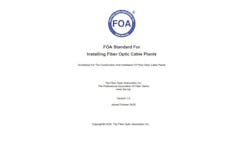New FOA Standard Addresses Fiber-Cable Plant Installation
The Fiber Optic Association (FOA) recently published a standard titled “FOA Standard For Installing Fiber Optic Cable Plants.” The standard replaces ANSI/NECA/FOA 301 Installing and Testing Fiber Optic Cables, which originally was published in 2000 and updated most recently in 2016.
In its October 2025 newsletter, the FOA discussed the previous standard, explaining, “Since standards are expected to be updated every 5 years, the next revision fell in the middle of the pandemic. We worked with some of the FOA technical advisors to create an update. Revisions of ANSI standards must be submitted for public comments and require consensus before publication. What we learned from the comments was that fiber optics had changed so much in 25 years that it would be difficult to create a simple standard to cover all the different applications of fiber optics around the world.
“After the comments period, it was decided to withdraw the 301 Standard and rethink the concept of a fiber-optic installation standard. It was time to step back and reconsider what such a standard should be.”
The result is a 61-page document with sections dedicated to the following areas of fiber-optic cable installation.
- Fiber Optic Installation Safety
- Cleanliness
- Fiber Optic Cable plant Topologies
- Fiber Optic Cable Plant Components
- Construction Guidelines
- Installation
- Installing Fiber Optic Cable
- Fiber Optic Splicing
- Fiber Optic Termination
- Testing the Installed Fiber Optic Cable Plant
- Administration, Management, and Documentation
The standard also includes three annexes, which cover loss-budget calculation, field-test requirements, and references along with other standards.
The FOA further explained in its newsletter that it “decided to use the expertise of our worldwide network of technical advisors, many of whom are also FOA instructors, whose knowledge and experience is unmatched. Many of them have contributed to the FOA knowledge base—textbooks, web pages, videos, and newsletter articles. The FOA knowledge base provided a basis for development of the standard and our advisors contributed much more. Drafts were circulated until we felt we had covered most of the applications.”
The FOA declares, “This is not your usual standard,” pointing specifically to the following characteristics of the document.
- It recognizes that every fiber-optic project is different … OSP or premises; underground or aerial; backbone or FTTx; LAN or data center.
- It provides guidelines for various installations, relying on the user to interpret these guidelines for their actual installation.
- It covers most installation types except submarine cables.
- It includes an annex of references to FOA technical material.
- It is open-source. Users are free to choose the sections that apply to their project, modify those sections to fit their project, and incorporate that into their scope of work or other project paperwork.
- It will be updated to reflect fiber-optic technology and applications in real time.
- It is free. The FOA does not charge for its technical materials and standards, as it is the association’s charter to provide assistance to the industry.
